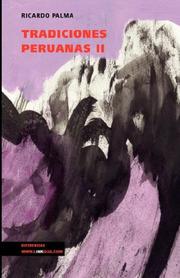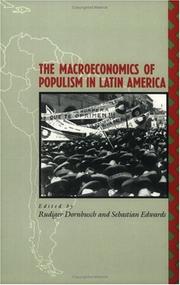| Listing 1 - 6 of 6 |
Sort by
|

ISBN: 8499537634 128202406X 9786612024061 849897741X 9788499537634 9788498165548 9781282024069 9788498977417 Year: 2014 Publisher: Chicago : Linkgua,
Abstract | Keywords | Export | Availability | Bookmark
 Loading...
Loading...Choose an application
- Reference Manager
- EndNote
- RefWorks (Direct export to RefWorks)
Las Tradiciones peruanas son una crónica apasionante de la historia del Perú, llena imágenes atrapadas entre el costumbrismo, la ironía y la reflexión cultural. Palma sorprende por la modernidad y agudeza de su prosa, por su voluntad de construir una memoria nacional de marcado valor estético.
Book
ISBN: 9781607320197 1607320193 9781607320180 1607320185 1607327120 9781607327127 1457110784 9781457110788 9781607329398 1607329395 Year: 2010 Publisher: University Press of Colorado
Abstract | Keywords | Export | Availability | Bookmark
 Loading...
Loading...Choose an application
- Reference Manager
- EndNote
- RefWorks (Direct export to RefWorks)
Through newly unearthed texts virtually unknown in Andean studies, Indians and Mestizos in the ""Lettered City"" highlights the Andean intellectual tradition of writing in their long-term struggle for social empowerment and questions the previous understanding of the ""lettered city"" as a privileged space populated solely by colonial elites. Rarely acknowledged in studies of resistance to colonial rule, these writings challenged colonial hierarchies and ethnic discrimination in attempts to redefine the Andean role in colonial society. Scholars have long assumed that Spanish rule remained
Political culture --- Social justice --- Anti-imperialist movements --- Learning and scholarship --- Peruvian literature --- Indian authors --- Mestizos --- Indians of South America --- History. --- History and criticism. --- Politics and government. --- Peru --- Intellectual life. --- Ethnic relations. --- Culture --- Political science --- Equality --- Justice --- Anti-colonialism --- Antiimperialist movements --- Social movements --- Imperialism --- National liberation movements --- Erudition --- Scholarship --- Civilization --- Intellectual life --- Education --- Research --- Scholars --- Authors, Indian --- Authors --- Eurindians (Latin America) --- Hispano-Indians (Latin America) --- Mestiços --- Indians --- Latin Americans --- Racially mixed people --- Mixed descent --- Bīrū --- Dēmokratia tou Perou --- Gweriniaeth Periw --- Jumhūrī-i Purū --- Jumhūrīyat Bīrū --- Lýðveldið Peru --- Pearu --- Peiriú --- Periw --- Pérou --- Peru ka Fasojamana --- Perú Kiōng-hô-kok --- Peru Respublikası --- Perua Respubliko --- Peruánská republika --- Peruko Errepublika --- Perun tasavalta --- Peruo --- Peruu --- Peruu Vabariik --- Pheroo --- Piru --- Piruw --- Piruw Suyu --- Pobblaght ny Peroo --- Purū --- Republic of Peru --- República del Perú --- Republica di u Perù --- República do Perú --- República Peruana --- Republiek van Peru --- Republik Peru --- Republika Peru --- Republikken Peru --- République du Pérou --- Rėspublika Peru --- Περού --- Δημοκρατία του Περού --- Рэспубліка Перу --- Република Перу --- Перу --- بيرو --- جمهورية بيرو --- پرو --- ペルー --- Peru-Bolivian Confederation --- Politics and government --- History --- History and criticism --- Ethnic relations --- Indians of South America - Peru - Politics and government --- Mestizos - Peru - Politics and government --- Indian authors - Peru - History --- Peruvian literature - Indian authors - History and criticism --- Learning and scholarship - Peru - History --- Anti-imperialist movements - Peru - History --- Social justice - Peru - History --- Political culture - Peru - History --- Peru - Ethnic relations --- Peru - Intellectual life
Book
ISBN: 997251000X 1413559174 2821844905 Year: 1996 Publisher: Institut français d’études andines
Abstract | Keywords | Export | Availability | Bookmark
 Loading...
Loading...Choose an application
- Reference Manager
- EndNote
- RefWorks (Direct export to RefWorks)
FRANCISCO PIZARRO y la conquista del Perú han sido motivo de innumerables trabajos, pero aún se pueden encontrar novedades en su estudio. Este libro descubre la dimensión empresarial de la conquista. El interés privado se revela como la fuerza que alentó la invasión europea del Perú, para luego obtener el gobierno del país. Sin embargo, el poder se mostró efímero y volátil para Pizarro y sus seguidores. Los nuevos datos aquí presentados, que el autor obtuvo en paciente búsqueda por archivos americanos y europeos, y el análisis que los acompaña, explican el surgimiento, desarrollo y decadencia de la organización pizarrista y del patrimonio que ésta controló. El aporte de esta investigación cambiará la manera de entender las primeras décadas de presencia española en el Perú.
Peru -- History -- Conquest, 1522-1548. --- Pizarro, Francisco, -- approximately 1475-1541. --- Pizarro, Francisco, -- aproximadamente 1475-1541. --- Pizarro, Gonzalo, -- -1548. --- Pizarro, Hernando, -- -1578. --- Regions & Countries - Americas --- History & Archaeology --- Latin America --- Pizarro, Hernando, --- Pizarro, Francisco, --- Pizarro, Gonzalo, --- Peru --- Per --- History --- Historia --- Pizarro González, Francisco, --- historia política --- Perú
Book
ISBN: 0773411429 9780773411425 Year: 2012 Publisher: Lewiston Edwin Mellen Press
Abstract | Keywords | Export | Availability | Bookmark
 Loading...
Loading...Choose an application
- Reference Manager
- EndNote
- RefWorks (Direct export to RefWorks)
Juan Cristobal Calvete de Estrella (c. 1510/20-1593) was a Spanish humanist with close connections to the courts of Charles V and Philip II, to the latter of whom he was a tutor. Among his many works in Latin and Spanish was De Rebus Indicis, a Latin history of the accounts of chroniclers, used documents probably supplied by the family of Cristobal Vaca de Castro, Francisco Pizarro's successor as governor. The book is commonly thought to be the longest continuous history of its subject in Latin. It tracks down and compares the primary sources drawn upon for De Rebus Indicis, in so far as these
America -- Discovery and exploration -- Spanish. --- Calvete de Estrella, Juan Cristóbal, d. 1593. De rebus Indicis. --- Peru -- History -- Conquest, 1522-1548. --- Regions & Countries - Americas --- History & Archaeology --- Latin America --- Calvete de Estrella, Juan Cristóbal, --- Peru --- America --- History --- Discovery and exploration --- Spanish.

ISBN: 0226158438 0226158446 9786611223298 1281223298 0226158489 9780226158488 9780226158440 9780226158433 9781281223296 6611223290 Year: 1991 Publisher: Chicago University of Chicago Press
Abstract | Keywords | Export | Availability | Bookmark
 Loading...
Loading...Choose an application
- Reference Manager
- EndNote
- RefWorks (Direct export to RefWorks)
Again and again, Latin America has seen the populist scenario played to an unfortunate end. Upon gaining power, populist governments attempt to revive the economy through massive spending. After an initial recovery, inflation reemerges and the government responds with wage an price controls. Shortages, overvaluation, burgeoning deficits, and capital flight soon precipitate economic crisis, with a subsequent collapse of the populist regime. The lessons of this experience are especially valuable for countries in Eastern Europe, as they face major political and economic decisions. Economists and political scientists from the United States and Latin America detail in this volume how and why such programs go wrong and what leads policymakers to repeatedly adopt these policies despite a history of failure. Authors examine this pattern in Argentina, Brazil, Chile, Mexico, Nicaragua, and Peru-and show how Colombia managed to avoid it. Despite differences in how each country implemented its policies, the macroeconomic consequences were remarkably similar. Scholars of Latin America will find this work a valuable resource, offering a distinctive macroeconomic perspective on the continuing controversy over the dynamics of populism.
Macroeconomics --- Economic policy and planning (general) --- Latin America --- Populism --- Congresses. --- Economic conditions --- Economic policy --- Asociación Latinoamericana de Libre Comercio countries --- Neotropical region --- Neotropics --- New World tropics --- Spanish America --- Political science --- economy, economics, economic, populist, regional, south, latina, latino, power, government, politics, political, spending, money, finance, financial, wages, price, deficit, capital, crisis, regime, economist, poli sci, argentina, brazil, chile, mexico, nicaragua, peru, history, historical, academic, scholarly, research, macropolicy, colombia, essay collection, anthology.
Book
ISBN: 997251353X 1413559514 282184428X Year: 2012 Publisher: Institut français d’études andines
Abstract | Keywords | Export | Availability | Bookmark
 Loading...
Loading...Choose an application
- Reference Manager
- EndNote
- RefWorks (Direct export to RefWorks)
El presente libro explora la historia de las guarangas —organizaciones sociopolícas fundamentales del mundo andino— y sus líderes, los caciques de guaranga, en el temprano siglo colonial en Huaylas. Estas estructuras políticas, intermedias entre los grandes señoríos/confederaciones y las pachacas o ayllus, constituyeron la base de cualquier organizacíon política y administrativa, tanto en la época preinca como en la inca y en la hispana. Una agregación de guarangas conformaba los señoríos, reinos o confèderaciones norteñas como Huaylas, Recuay, Jauja, Tarma o Cajamarca antes de la conquista inca. Ellas constituyeron también la base de las provincias incas y de las encomiendas hispanas. Las guarangas fueron los elementos bisagra que confirieron legitimidad y coherencia los sucesivos cambios o adaptaciones políticas que se produjeron antes y después de las conquistas inca e hispana y que los hicieron posibles. Sus autoridades máximas, los curacas de guaranga, se convirtieron en los mediadores fundamentales entre los conquistadores y las sociedades conquistadas y su continuidad y participación activa en la construcción y moldeamiento del nuevo sistema permitió hacer posible la difícil transición entre el mundo inca y el español. Cuando la organización inca se derrumbó, y con ella las provincias y mitades administrativas, fue esta estructura política intermedia la que sobrevivió y prevaleció constituyendo una de las principales bases d eorganizació sobre la que se sustentaron no sólo el primer sistema colonial, el de la encomienda, sino también las reformas toledanas y los pueblos de indios coloniales. El papel estratégico que conservaron los caciques de guaranga en el nuevo sistema imperial de poder les permitió erosionarlo desde adentro y reencauzarlo de una forma menos lesiva a sus intereses.
Indians of South America -- Peru -- Huaylas (Province) -- Politics and government -- 16th century. --- Indios de América del Sur -- Perú -- Huaylas (Provincia) -- Política y gobierno -- Siglo XVI. --- Perú -- Historia -- Conquista, 1522-1548. --- Peru -- History -- Conquest, 1522-1548. --- Indians of South America --- Regions & Countries - Americas --- History & Archaeology --- Latin America --- Politics and government --- Indios de América del Sur --- Política y gobierno --- Peru --- Per --- History --- Historia --- American aborigines --- American Indians --- Indigenous peoples --- Ethnology --- conquête espagnole --- pouvoir --- ethnologie --- époque coloniale --- encomienda --- Pérou --- administration coloniale --- cacique
| Listing 1 - 6 of 6 |
Sort by
|

 Search
Search Feedback
Feedback About UniCat
About UniCat  Help
Help News
News